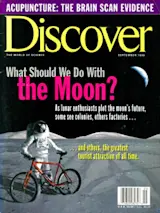As the members of the solar system roam the sky, we're treated to endless meetings between them. Look up on September 6 and watch how the moon narrowly passes Jupiter, then visits Saturn two nights later. The pair of naked-eye conjunctions are repeated on October 3 and 6.
A zodiac creeper such as Jupiter will frequently meet other planets. It has only to linger while fast-lane Venus and Mars pay a call every year or two on their speedy rounds. All manner of planetary permutations thus parade overhead for our enjoyment. One bright conjunction, however, remains elusive: the meeting of Jupiter and Saturn. This encounter, alone among the many cyclic planetary patterns noticed by ancient sky watchers, requires steadfast patience.
Enormous Jupiter, the most brilliant "star" of the midnight heavens, overtakes bright, lethargic Saturn once in 20 years. You'll have an opportunity to see this meeting only a few times ...














